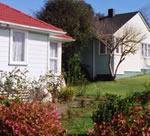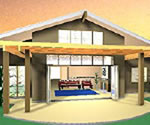State House Style
Elevation of a typical state house in 1930s and 40s
State houses in Otara
Publicity photo emphasising state house family life
![]() Gordon Wilson (1940s Government Architect)
discusses state house design
Gordon Wilson (1940s Government Architect)
discusses state house design
Multi-unit housing in Porirua East built in 1950s and 60s
Cluster complex in Mount Albert, Auckland
Design for whanau whare (family house)
The design of state houses has been fodder for armchair and professional critics since the beginning. Detractors slagged the first workers' dwellings for being 'too swell' and called for simpler shelters. Half a century later the complaint was the exact opposite: that new state houses were stingy, shoddy and slum-like. But who was right and who was wrong often came down to one's political perspective. Right-leaning critics have asserted that it's not the state's role to build workers 'luxury' homes, whereas those to the left have argued that raising housing standards raises living standards.
Only the Best
To avoid replicating the working-class slums of Britain, the first state houses in the 1900s were to be designed and constructed to the highest possible standard budgets permitted. Furthermore, no two houses would be exactly alike, so that their occupants would not be identifiable as state tenants.
Similar sentiments guided the first Labour government's scheme. State housing areas would contain both better-off and poor workers to avoid the creation of single-class neighbourhoods. As with the workers' dwellings, each house would be constructed using quality labour and materials, and designed to last for 60 years.
Internal planning was equally important. Kitchens would face the morning sun and living rooms would form the centre of family life, arranged so that easy chairs could encircle the fireplace.
Building State Houses: Len Home
Len Home ‘fell into' building. His father had created a successful building business in Timaru in the 1920s, but he'd never considered following him into the trade. At the end of his schooling Len decided to work with his father while he figured out what he wanted to do. This became ‘a permanent situation'.
Used to building bungalows, Len's father wasn't initially impressed with the state house, but was won over when he realised that building them would mean that he'd no longer have to draw plans and deal with irksome clients. He tendered and won contracts for ten state houses in Temuka – the first of hundreds he would build. Len continued to work for his father and eventually took over the business. He had a maximum of twelve men working for him, including at least two apprentices at any one time.
Len thinks that state houses were ‘sensibly designed', but believes that later ones have less aesthetic appeal than their predecessors. Still, he considers that state housing has contributed a lot to Timaru.
Box image: Row of state houses in Hamilton
Photographer:
Victoria Birkinshaw, 2004
Cutting Corners
There is little doubt that the state houses of the 1930s and 40s raised the standard of housing in New Zealand. (Interestingly, the recent 'leaky building crisis' has seen some homebuyers spurn modern homes and seek these ex-state houses knowing that they were very well built.) Less certain is the legacy of what followed. Escalating building costs in the 1950s led the National government to lower the standard of new state housing. The results were not pretty. In places like South Auckland and Porirua, uniformity of design, the dominance of poor households, and a lack of services and amenities, eventually created the ghetto communities Seddon and Savage had so wanted to avoid.
Subsequent governments have tried to correct these mistakes. From the 1970s new state housing areas were set alongside (more costly) private developments and closer to workplaces, transport links and other facilities. New housing designs were also introduced to take account of changing living arrangements, such as the 'family' (or dining) room, now adjacent to the kitchen, but distinct from the living room.
Building State Houses: John Dunlop
John Dunlop initially erected private houses, but soon realised that the builders who were prospering were those building state houses, so started tendering for state housing contracts around Porirua. After winning a few, he took on extra workers until he was employing more than twenty men, making him among the largest builders in the district. Throughout his career he had a great relationship with the Housing Division, whose staff were ‘excellent people', ‘straightforward and honest'.
John's biggest moment came when he was selected by the government to show the Queen around one of his houses on her 1963 visit to New Zealand. ‘She knew an awful lot about housing', he recalls. She inspected every room except the toilet, and then:
gave me a hard time about the prams. She asked me, ‘Where do you put the prams?' (She was a bit on the women's lib side of this, you see.) I said, ‘In the bedroom.' I was so nervous that I didn't tell her that New Zealand prams were half the size of those in the UK . She was having me on a bit, I think.
John thinks that the houses he built were well-designed. They were all pitched for sun. The bedrooms and bathrooms were small, but adequate. He concedes that the multi-units were unpopular with tenants. They were ‘not attractive looking … [and] people didn't like them.… [Yet] from a functional point of view there was nothing wrong with them. For places to sleep, eat, etcetera, they were just as good as single houses.' He also thinks that state housing has made a ‘hang of a difference' to New Zealand society: ‘It's brought people who had no show in life and given them a chance'.
Box image: The Queen visiting state houses in 1963
Photographer: John Dunlop
One Design Doesn't Fit All
Few designs, however, accommodated the practices of those outside the dominant Pakeha culture. One Maori tenant, long accustomed to the separation of food from washing areas, recalled her horror at finding the only place she could wash clothes was the kitchen sink: 'these houses were designed by English people who are happy to wash their pants in the sinkwell I wasn't going to be happy washing my babies nappies in there'.
More recently, Housing New Zealand Corporation has promoted the construction of state houses that better reflect the increasingly diverse cultural needs of its tenants. Its Maori and Pacific design guides, released in 2002, are intended to alert designers to the cultural beliefs and practices that they need to consider when building state houses for these groups.
Next: Outside the Mainstream >








